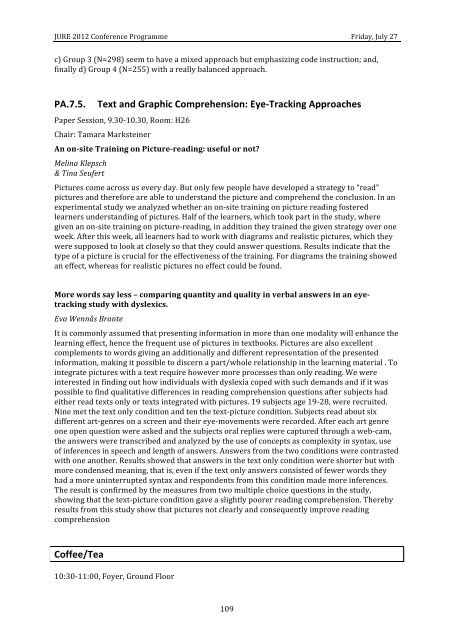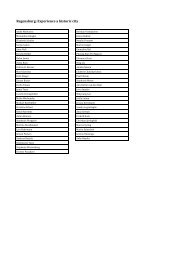JURE 2012 Programme book - EARLI Jure 2012
JURE 2012 Programme book - EARLI Jure 2012
JURE 2012 Programme book - EARLI Jure 2012
You also want an ePaper? Increase the reach of your titles
YUMPU automatically turns print PDFs into web optimized ePapers that Google loves.
<strong>JURE</strong> <strong>2012</strong> Conference <strong>Programme</strong> Friday, July 27<br />
c) Group 3 (N=298) seem to have a mixed approach but emphasizing code instruction; and,<br />
finally d) Group 4 (N=255) with a really balanced approach.<br />
PA.7.5. Text and Graphic Comprehension: Eye-‐Tracking Approaches<br />
Paper Session, 9.30-‐10.30, Room: H26<br />
Chair: Tamara Marksteiner<br />
An on-‐site Training on Picture-‐reading: useful or not?<br />
Melina Klepsch<br />
& Tina Seufert<br />
Pictures come across us every day. But only few people have developed a strategy to “read”<br />
pictures and therefore are able to understand the picture and comprehend the conclusion. In an<br />
experimental study we analyzed whether an on-‐site training on picture reading fostered<br />
learners understanding of pictures. Half of the learners, which took part in the study, where<br />
given an on-‐site training on picture-‐reading, in addition they trained the given strategy over one<br />
week. After this week, all learners had to work with diagrams and realistic pictures, which they<br />
were supposed to look at closely so that they could answer questions. Results indicate that the<br />
type of a picture is crucial for the effectiveness of the training. For diagrams the training showed<br />
an effect, whereas for realistic pictures no effect could be found.<br />
More words say less – comparing quantity and quality in verbal answers in an eye-‐<br />
tracking study with dyslexics.<br />
Eva Wennås Brante<br />
It is commonly assumed that presenting information in more than one modality will enhance the<br />
learning effect, hence the frequent use of pictures in text<strong>book</strong>s. Pictures are also excellent<br />
complements to words giving an additionally and different representation of the presented<br />
information, making it possible to discern a part/whole relationship in the learning material . To<br />
integrate pictures with a text require however more processes than only reading. We were<br />
interested in finding out how individuals with dyslexia coped with such demands and if it was<br />
possible to find qualitative differences in reading comprehension questions after subjects had<br />
either read texts only or texts integrated with pictures. 19 subjects age 19-‐28, were recruited.<br />
Nine met the text only condition and ten the text-‐picture condition. Subjects read about six<br />
different art-‐genres on a screen and their eye-‐movements were recorded. After each art genre<br />
one open question were asked and the subjects oral replies were captured through a web-‐cam,<br />
the answers were transcribed and analyzed by the use of concepts as complexity in syntax, use<br />
of inferences in speech and length of answers. Answers from the two conditions were contrasted<br />
with one another. Results showed that answers in the text only condition were shorter but with<br />
more condensed meaning, that is, even if the text only answers consisted of fewer words they<br />
had a more uninterrupted syntax and respondents from this condition made more inferences.<br />
The result is confirmed by the measures from two multiple choice questions in the study,<br />
showing that the text-‐picture condition gave a slightly poorer reading comprehension. Thereby<br />
results from this study show that pictures not clearly and consequently improve reading<br />
comprehension<br />
Coffee/Tea<br />
10:30-‐11:00, Foyer, Ground Floor<br />
109



